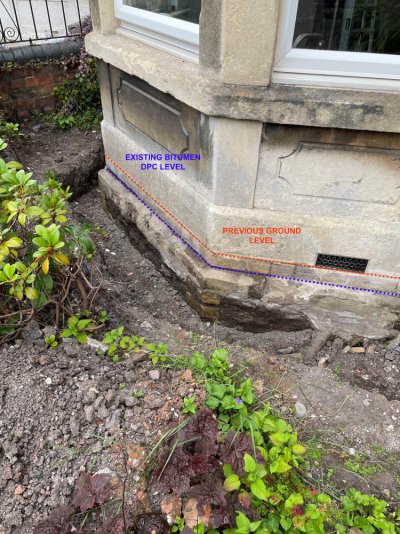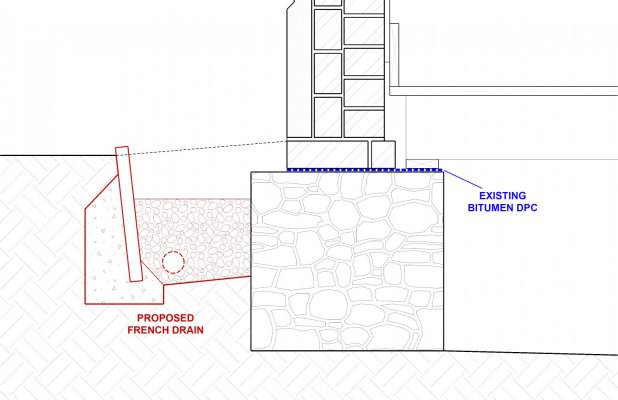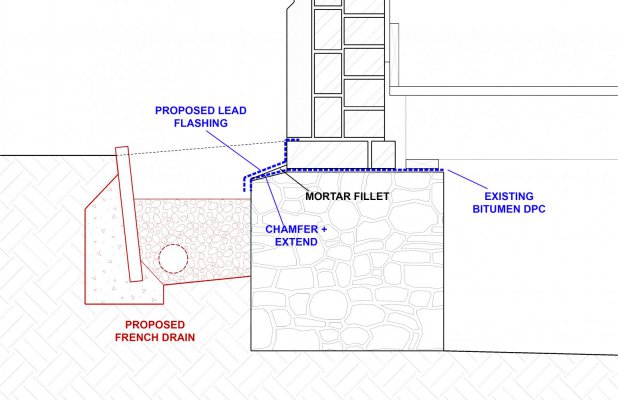Hi All,
As part of a full renovation to a 1906 bay fronted terrace, I have been attempting to solve a number of damp issues that have affected the downstairs front room, largely around the bay window and porch areas. I think (hope!) I am mostly there but am somewhat stuck on how to detail the connection between the existing footings and bitumen DPC. The situation seems unusual as I have not yet come across an example where the DPC has been applied directly to the top of the footings as in my case.
For context:
- The external ground levels were previously above DPC level and formed from a concrete skirt which I have removed (see picture)
- The footing was in a poor state when uncovered, with significant portions of pointing missing so I patched it up rather messily with NHL 3.5 at the time not thinking it would remain visible.
- The footing is constructed from random rubble of various types, with brick corners.
- I am in the process of installing a French drain around the front of the property. This will be around 400mm deep (the footings are around 600-700mm) and will drain to a small soakaway.
The main problem is that rain collects on the top of the footing, then runs into the mortar joint thus bypassing the dpc (which has also become degraded on the outer face). It would be ideal to lower the height of the footing to at least one course below the dpc, but this would be challenging due to its rubble construction, and would probably further damage the dpc itself in the process.
As such my current plan is to:
- Cut the top of the footing to provide a fall
- Extend the existing dpc over the top face of the footing using tanking slurry or a bituminous coating.
- Introduce a mortar fillet to increase the fall
- Install lead flashing from the mortar joint above to protect the area, provide a drip into the French drain and visually cover the brick, mortar and rubble that was never meant to be seen (see sketch).
Any advice if anyone has any experience with similar situations, thoughts on my plan or alternative approaches would be greatly appreciated!



As part of a full renovation to a 1906 bay fronted terrace, I have been attempting to solve a number of damp issues that have affected the downstairs front room, largely around the bay window and porch areas. I think (hope!) I am mostly there but am somewhat stuck on how to detail the connection between the existing footings and bitumen DPC. The situation seems unusual as I have not yet come across an example where the DPC has been applied directly to the top of the footings as in my case.
For context:
- The external ground levels were previously above DPC level and formed from a concrete skirt which I have removed (see picture)
- The footing was in a poor state when uncovered, with significant portions of pointing missing so I patched it up rather messily with NHL 3.5 at the time not thinking it would remain visible.
- The footing is constructed from random rubble of various types, with brick corners.
- I am in the process of installing a French drain around the front of the property. This will be around 400mm deep (the footings are around 600-700mm) and will drain to a small soakaway.
The main problem is that rain collects on the top of the footing, then runs into the mortar joint thus bypassing the dpc (which has also become degraded on the outer face). It would be ideal to lower the height of the footing to at least one course below the dpc, but this would be challenging due to its rubble construction, and would probably further damage the dpc itself in the process.
As such my current plan is to:
- Cut the top of the footing to provide a fall
- Extend the existing dpc over the top face of the footing using tanking slurry or a bituminous coating.
- Introduce a mortar fillet to increase the fall
- Install lead flashing from the mortar joint above to protect the area, provide a drip into the French drain and visually cover the brick, mortar and rubble that was never meant to be seen (see sketch).
Any advice if anyone has any experience with similar situations, thoughts on my plan or alternative approaches would be greatly appreciated!



